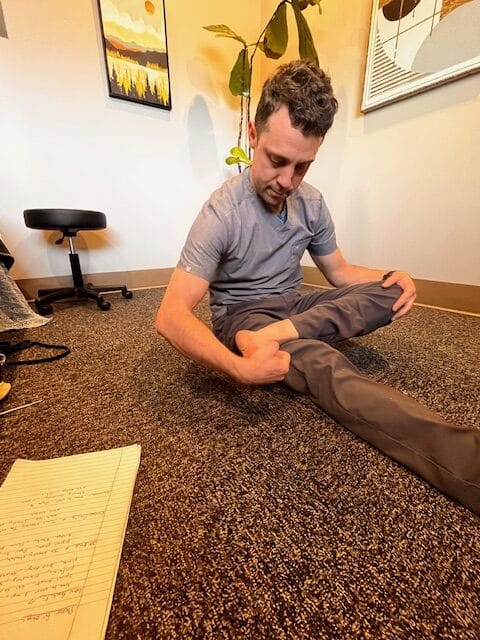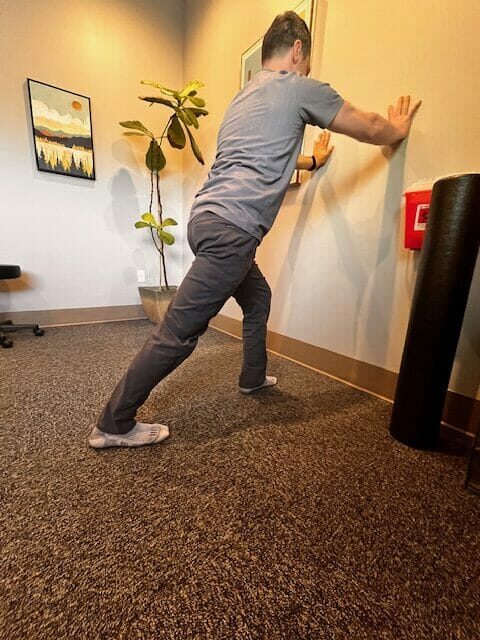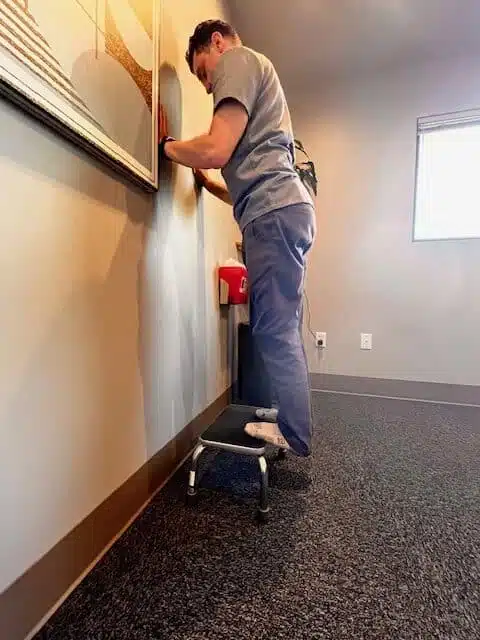Last Updated on June 8, 2024
Plantar fasciitis is a common condition that affects the heel and the bottom on the foot. It is often the cause of chronic heel pain.
Plantar fasciitis is characterized by the inflammation of the plantar fascia, the thick band of tissue that runs across the bottom of your foot connecting from your heel to the base of your toes. When inflamed the fascia causes a sharp and stabbing pain that is often most severe with the first steps in the morning.
For some people, the discomfort typically decreases throughout the morning as the foot warms up with use. Unfortunately the pain then returns after long periods of standing or when standing up after sitting.
Treatment for plantar fasciitis includes rest, ice, and over-the-counter pain relievers. To improve outcomes and heal faster it is essential to experiment and practice stretching and strengthening exercises.
Effective stretches target not only the plantar fascia itself but also the Achilles tendon and calf muscles, which are integral to foot health and mechanics. These muscles all connect and the calcaneus, or heel bone.
Key Takeaways
- Plantar fasciitis is a common cause of heel pain, originating from inflammation of the foot’s plantar fascia.
- Conservative treatments, including stretching exercises, are first-line strategies for alleviating symptoms.
- Proper foot mechanics, supportive footwear, and regular monitoring help manage plantar fasciitis long-term.
Understanding Plantar Fasciitis
Plantar fasciitis involves inflammation of the plantar fascia, a fibrous ligament that connects the heel to the front of the foot. The fascia is tough and durable. It holds the entire weight of the body during walking and running. It also supports the arch and sustains the foot through movement.
Symptoms of Plantar Fasciitis
Individuals with plantar fasciitis typically experience foot pain and tenderness in the heel and arch of the foot.
The discomfort is most pronounced after periods of inactivity, like sleeping or sitting, it might improve with some activity. But can return with sustained activities like running.
Patients often describe plantar fasciitis pain as a sharp, stabbing sensation in the heel or a dull ache across the bottom of the foot.
Causes and Risk Factors
This condition is generally considered an overuse injury. It is frequently seen in runners and other individuals whose activities place a lot of tension on the foot. However, It can also be seen in people who are not active.
The risk factors include:
- High-impact sports: Involvement in sports that increase stress on the heel and attached tissue.
- Foot mechanics: A high arch or flat feet will distribute the pressure on the foot unequally.
- Obesity: Extra weight puts more stress on the plantar fascia.
- Occupations: Jobs that require prolonged standing or walking on hard surfaces.
- Age: People between the ages of 40 and 60 are more susceptible to plantar fasciitis.
- Bad shoes: not replacing shoes often can increase the risk of developing plantar fasciitis.
Diagnostic Approach
A clinician usually diagnoses plantar fasciitis based on the patient’s history of foot pain and a physical examination.
Signs the specialist looks for include:
- Swelling or redness in the foot.
- Pain with direct palpation of the plantar fascia.
- Increased pain with dorsiflexion of the toes, which stretches the plantar fascia.
- Limited ankle flexibility, which may suggest a shortened Achilles tendon.
The diagnosis is often confirmed without the need for imaging tests, though persistent or uncertain cases may be investigated with ultrasound or MRI to rule out other causes of heel pain or bone spurs.
Initial Treatment Strategies
Initial treatment strategies for plantar fasciitis typically consist of non-invasive methods. These strategies include proper rest and lifestyle adjustments, stretching and strengthening, and using support devices and footwear to mitigate stress on the plantar fascia.
Rest and Lifestyle Adjustments
Rest is crucial for patients with plantar fasciitis, as it allows the inflamed tissue to heal without being re-aggravated.
It is important to maintain but limit activities that aggravate heel pain, such as walking or standing. Go on shorter walks to maintain strength and circulation but avoid walking too long which would aggravate the tissue.
Home remedies like gentle stretching exercises can also improve symptoms and support the healing process.
Pain Management Techniques
To achieve pain relief, patients may use over-the-counter anti-inflammatory medication, such as ibuprofen or naproxen.
Icing the affected area several times a day can reduce swelling and provide temporary pain relief.
Support Devices and Footwear
Supportive shoes with proper cushioning and shock absorption qualities are essential to reduce stress on the plantar fascia.
Shoe inserts or custom orthotics can provide additional arch support and cushioning.
For some, wearing a night splint to keep the foot in dorsiflexion may greatly reduce the symptoms of plantar fasciitis.
Recommended Stretches and Exercises
Incorporating specific exercises and stretches into one’s routine can significantly alleviate the symptoms of plantar fasciitis.
These stretches target both the plantar fascia itself, as well as the muscles of the calves and the Achilles tendon.
Plantar Fascia Specific Stretches
Seated Towel Stretch: Ideally performed in the morning, the individual sits on a bed with legs straight ahead, wraps a towel around the toes, and gently pulls the towel towards themselves, keeping the knees straight. You can gently pulse the towel. You can push against the towel for a count of 5 and then pull deeper into the stretch. Try to stretch for 10- 30 seconds.

Toe Extension: While seated, place the affected foot over the opposite knee, grab the toes, and pull them back towards the shin until a stretch along the arch is felt. Again try pulsing the stretch or using 5 seconds of resistance before moving deeper into the stretch.

Arch Roll: Using a round object like a tennis ball or a golf ball, roll the arch of the foot back and forth to massage and stretch the plantar fascia.
Calf and Achilles Tendon Stretches
Standing Calf Stretch: Facing a wall, place your hands on the wall, extend the affected leg back, place the toes on the ground, and then stretch the heel on the ground. Be gentle and listen to your body, don’t overdo it. This stretch can be performed with the knee straight and with the knee bent.

Stair Stretch: Standing on a step with heels hanging off, slowly lower your heels down to stretch the calves and Achilles tendon.

Strengthening Exercises for Stability
Heel Raise: From a standing position, slowly raise your heels off the ground, then lower them to strengthen the calf muscles. Try this on stairs for a greater range of motion.

Toe Walks: By walking on the toes, one can enhance muscle strength in the calf and the stability of the ankle.
Abductor Hallucis Strengthening: This involves scrunching a towel with the toes or picking up objects, which strengthens the small muscles underneath the foot, providing additional support to the plantar fascia during activities such as running or hiking.
Therapies and Rehabilitation
Direct treatment approaches are designed to restore function, alleviate pain, and address the underlying causes of the injury.
Acupuncture and Chiropractic Interventions
Direct treatment of plantar fasciitis can greatly improve recovery time. Treatment typically involves targeting the fascia and the gastrocnemius and soleus muscles.
Generally, manual therapy techniques, such as massage and mobilization, are employed to enhance the function of foot and ankle structures. Manual therapy will assist with self-myofascial release, helping to relieve tightness and promote recovery.
Your clinician may introduce and guide you through the following exercises:
- Toe stretches: pulling back on the toes to stretch the plantar fascia.
- Calf stretches: placing hands against a wall and stepping back with one foot to stretch the lower leg tendons.
- Plantar fascia-specific stretch: Pull the toes up with a towel to isolate the stretch on the plantar fascia.
Advanced Pain Relief Techniques
The American Academy of Orthopaedic Surgeons recommends the use of ice massage and other pain relief modalities to reduce inflammation caused by plantar fasciitis.
These techniques may include:
- Ice therapy: rolling the foot over a frozen water bottle or applying an ice pack to the affected area.
- Ultrasound therapy: using sound waves to promote healing and decrease inflammation.
- Electrotherapy: applying electrical stimulation to reduce pain and improve function.
Preventative Measures and Lifestyle Modifications
To mitigate the risks of developing plantar fasciitis, individuals should focus on adopting appropriate exercise techniques and ensuring they use proper footwear that provides adequate support.
These proactive strategies can help maintain the health of the heel and ankle, especially for those frequently engaged in high-impact activities such as running, jumping, or sports like soccer.
Exercise Modification and Technique
It’s critical for runners and athletes to incorporate exercise modifications to reduce the chance of an overuse injury. Once symptoms are first felt, modify exercise by cross-training.
This includes varying their workout routines to avoid excessive strain on the plantar fascia. For example, maintain strong cardio exercise by increasing pool time. This will keep the lungs strong and allow the fascia time to rest and recover.
Often working on strengthening the core is recommended to reduce repetitive exercises like running and allow secondary muscles of stabilization to be strengthened.
Many endurance athletes like triathletes understand these concepts well and will occasionally focus on low-impact cross-training—such as swimming or cycling—to give their feet a break from repetitive high-impact pressures.
Footwear and Orthotic Considerations
Choosing the right footwear is imperative for those seeking to prevent plantar fasciitis.
Supportive shoes with adequate arch support and cushioning can substantially decrease the risk for those who stand for extended periods or are regularly active.
It is often advisable for individuals to consult with a professional to ensure the proper selection of orthotic inserts that can offer customized heel and arch support.
- Footwear Guidelines:
- Ensure the shoe fits well with enough room for toes to move freely.
- Replace shoes regularly to maintain adequate cushion and support.
For those with an existing predisposition or past injuries, specially designed insoles or custom orthotics provided by a healthcare professional may be a worthy investment.
These can especially be of great help to active individuals, effectively distributing pressure across the foot and offering protection against the repetitive stress associated with running and jumping.
Long-Term Management and Monitoring
Managing plantar fasciitis requires consistent effort to alleviate symptoms and prevent recurrence.
This includes routine visits to healthcare providers, adapting activities to reduce heel pain, and maintaining a regimen of stretching and strengthening exercises.
Follow-Up with Healthcare Professionals
Patients with plantar fasciitis should schedule regular follow-up appointments with their clinicians to ensure proper management of their condition.
These check-ins allow healthcare professionals to assess the progression of healing, monitor for signs of inflammation or tears, and adjust treatment plans accordingly.
Adapting Daily Activities for Comfort
Modifying daily activities is crucial for those experiencing plantar fasciitis.
Patients should be advised to:
- Avoid sports and activities that place excessive stress on the calves and heel.
- Choose footwear that provides adequate support to minimize pain while walking.
- Consider using tools like a rolling pin or a frozen water bottle under the foot to soothe inflammation.
Ongoing Stretching and Strengthening
To support long-term healing, patients should commit to an ongoing stretching and strengthening routine targeting the calf muscles and plantar fascia.
Exercises might include:
- Calf stretches: Recommended twice a day to increase flexibility.
- Plantar fascia stretches: To be performed regularly to alleviate tension.
- Strengthening exercises: Such as toe curls and doming to build arch support.
These interventions, when applied consistently, can help manage symptoms and contribute to a more favorable outcome in the long term.
When to Seek Further Medical Advice
It is advisable to consult a healthcare professional, such as a physical therapist, if:
- The pain is sudden and severe.
- There is an inability to flex the foot without significant pain.
- The symptoms do not improve with rest and appropriate stretches.
An experienced clinician can assess the condition and provide a tailored treatment plan. They will also know if any red flags are present and can make appropriate referrals if needed.
If the heel pain is severe, causing limping or making it challenging to stand or walk, it is crucial to seek immediate medical attention to prevent further damage.
Community and Support Resources
Support groups and forums online are invaluable resources, allowing patients to exchange information on effective stretching techniques for the calf muscles and other therapeutic practices.
Websites like that of the American Academy of Orthopaedic Surgeons offer expert-vetted advice and can direct individuals to local support options.
Furthermore, community centers and healthcare facilities sometimes organize group sessions led by professionals where participants engage in guided stretches that target the plantar fascia and calf muscles.
This group setting not only fosters a sense of camaraderie but also ensures that stretches are performed correctly.
Below is a brief outline of resources that can provide support and information:
- Local Running Clubs and Groups:
- Workshops on foot care
- Experiences shared between runners
- Online Platforms:
- Forums and discussion boards
- Social media groups dedicated to plantar fasciitis
- Medical Associations:
- Guides and resources from the American Academy of Orthopaedic Surgeons
- Community Healthcare Resources:
- Group physiotherapy sessions
- Access to professional guidance on exercises
It is important for patients to remember that professional medical advice should be the primary source of information when dealing with plantar fasciitis.
Community resources are supplementary aids that can offer support and additional insight into managing the condition effectively.
Frequently Asked Questions
These questions aim to inform about effective stretching strategies for individuals experiencing plantar fasciitis, emphasizing specific exercises and cautions.
What stretches can alleviate pain from plantar fasciitis?
Stretches targeting the plantar fascia can provide significant pain relief.
A plantar fascia-specific stretching exercise shown to be beneficial involves pulling the toes towards the shin until a stretch in the arch is felt.
Are there specific stretches recommended for plantar fasciitis relief before getting out of bed?
Yes, before getting out of bed, stretching the plantar fascia can be helpful.
This typically involves flexing the foot and toes upward to stretch the arch of the foot.
What exercises should be avoided if one has plantar fasciitis?
Individuals with plantar fasciitis should avoid high-impact activities such as running or jumping which can exacerbate heel pain.
Can stretching exercises accelerate the healing process of plantar fasciitis?
Engaging in tissue-specific plantar fascia stretching exercises can enhance the outcomes and potentially speed up the healing process for chronic heel pain associated with plantar fasciitis.
How does using a ball for foot stretches aid in the recovery from plantar fasciitis?
Rolling a ball under the foot provides a massage effect that can help to stretch the plantar fascia, improve blood flow, and reduce discomfort.
What are the most effective quick-relief methods for plantar fasciitis symptoms?
For quick relief, applying ice to reduce inflammation and performing gentle stretches can help. Using supportive footwear can also effectively alleviate the symptoms of plantar fasciitis.

